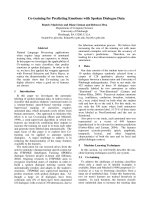facilitation training for team members 25066
Bạn đang xem bản rút gọn của tài liệu. Xem và tải ngay bản đầy đủ của tài liệu tại đây (246.55 KB, 121 trang )
Facilitation
Skills
Learning Objectives
.To understand the roles of
facilitators
.To understand the facilitator’s basic
responsibilities
.To understand the structure of
facilitation map
.To understand the basic facilitation
skills
Program Outline and
Timelines
1.Getting Started – 30 minutes
2.Basic Responsibilities of a Facilitator
– 120 minutes
3.Basic Facilitation Map – 60 Minutes
4.The Facilitation Techniques – 180
minutes
❙ 5.Conclusion – 30 minutes
❙
❙
❙
❙
❙
Timetable
8.30 am – 9.00 am
9.00 am – 10.00 am
10.00 am- 10. 15 am
10.15 am – 11.15 am
11.15 am – 12.15 pm
12.15 pm – 1.15 pm
1.15 pm – 3.00 pm
(I)
3.00 pm – 3.15 pm
3.15 pm – 4.30 pm
(II)
4.30 pm - 5.00 pm
Getting started
Basic Responsibilities (I)
Break
Basic Responsibilities (II)
Basic Facilitation Map
Lunch Break
Basic Facilitation Techniques
Break
Basic Facilitation Techniques
Conclusion
Module 1 Getting Started
Getting Started
Warm Up
Name Your Team
Module 1 Getting Started
1. What do you think a
facilitator is?
Module 1 Getting Started
What do you think a facilitator
is?
Facilitator is the individual
responsible
for guiding a team through a process in
order to accomplish a specific task or
achieve a specific goals or outcomes
Module 1 Getting Started
2. The Business Environment and the
role of Facilitator (read notes)
What’s today’s business situation?
Volatile or Stable? Fast product
cycle or slow cycle?
Module 1 Getting Started
2. The Business Environment
and the role of Facilitator
(read notes)
Fast !! Do it first.
Task Behaviors
Task behaviors
•
•
Doing
Work Independently
Making logic-based decisions
Acting
Moving things along
Focusing on details
Directing
Bringing things to closure (making decisions)
Controlling
Telling
Focusing on the job at hand
Resistance to change
Module 1 Getting Started
3. The importance of
facilitation to enhance
process behaviors
Success though planning
and discussion
Process Behaviors
❘
Thinking
Participating/teamwork
Using creativity and intuition
Talking
Exploring ideas more deeply
Focusing on the big picture
Facilitating
Opening up/looking for other ideas (generating
alternatives)
Letting go and empowering
Asking
Focusing on the people, values, and vision
Receptivity to change
4. The Role of Facilitator
The facilitator’s task is to ensure that
a team
a. avoids the potential disadvantages and
b. experiences all of the advantages
and so performs as a synergistic team
creating
excellent outcomes
Komag’s Definition
❚ The definition of facilitation
Komag’s SDWT Context
❚ Facilitator is the individual
who designs and manages of
structures and processes that
help a group do its work and
minimize the common problems
The Role of Facilitator
Role of Facilitator
+
Experience all the advantages Avoid the potential disadvantages
Synergistic team
Excellent Outcomes
5. Working In a Team
Advantages
Disadvantages
5. Working In a Team
Potential Advantage
Potential Disadvantages
Building on each others’ ideas
Confusion
Different perspectives
No agreement
Better conclusion
Conflict
Fun
No time for individual thinking
Sharing the load
Can avoid responsibilities
Equation
In a Dysfunctional Team
2 + 2 = 3 or less
In a Synergistic Team
2 + 2 = 4 or more
Role of Facilitator
+
Experience all the advantages Avoid the potential disadvantages
5. Synergy or Dysfunction?
Synergistic team
Excellent Outcomes
Definition of Word
❚ synergy, synergism
noun [U]
SPECIALIZED
the combined power of a group of
things when they are working together
which is greater than the total power
achieved by each working separately
❚ (from
Cambridge International Dictionary of
English
)
❚ dysfunctional
adjective
not able to operate well;
working badly
a dysfunctional family
❚ from
Cambridge Dictionary of America
n English
)
Core Processes of Facilitation
1. Analyzing Information to determine
the best approach
2. Designing Meeting (Facilitation
Map)
3. Establishing group climate, norms
and roles with the team (Ground
Rules)
4. Creating and implementing
structures and processes to
accomplish tasks and meet objectives
Core Processes of Facilitation
5.
6.
7.
8.
Intervening to manage group dynamics and
to influence what members are doing or how
they are doing it (Basic Facilitation
Skills)
Coaching team leaders and team members in
effective behaviors
Evaluation meeting and facilitation
effectiveness to enhance team learning
(Facilitator Feedback)
Ensuring follow-up action related to
production, meeting, results, communication
and implementation of decision.
Conclusion
Facilitator is essential for today’s business
in two aspects:
a. It helps the team to focus on process
behaviors, that is planning, thinking and
discussion
b. It helps the team to bring out the best
part of team to be more synergistic.









